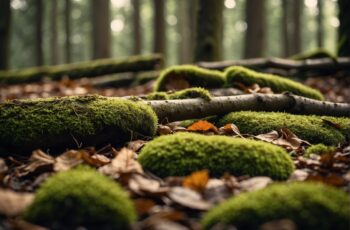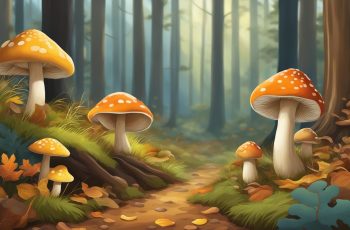Morel mushrooms in Ohio are a much-anticipated delicacy that beckons mushroom hunters to the state’s forests each spring. Known for their distinct honeycomb appearance and rich, earthy flavor, morels are among the most coveted wild mushrooms. In Ohio, the morel season is a short but thrilling time when foragers eagerly scan the forest floor for these elusive fungi. Whether you’re a seasoned forager or a novice eager to join the hunt, understanding the habitat and characteristics of morels is key to a successful harvest.

As you prepare for your morel foraging adventure, it’s essential to equip yourself with knowledge of the different types of morels found in Ohio. Black, white, and yellow morels each have unique traits and grow in varying environments. While black morels are often the first to appear and can be challenging to spot, the larger white and yellow varieties may be easier to find. Familiarizing yourself with these mushrooms and their preferred conditions can dramatically increase your chances of a bountiful foray into Ohio’s rich ecosystems.
Key Takeaways
- Morel hunting is a popular spring activity for Ohio’s outdoors enthusiasts.
- Knowledge of morel varieties and habitats increases foraging success.
- Proper identification and harvest techniques are crucial for a rewarding morel season.
Identifying Morels in Ohio
When you’re scouring Ohio’s forests for morels, knowing how to distinguish between the edible true morels and the potentially toxic false morels is critical. You’ll frequently find these mushrooms in association with certain trees, so being able to pinpoint these habitats increases your chances of a successful forage.
True Morels vs False Morels
True Morels: True morels stand out with their deeply pitted and honeycomb-like caps. When you slice a true morel down the middle, you’ll find it’s completely hollow from stem to tip, which is a hallmark feature of edible morels. Common varieties you’ll encounter include the Half-Free Morel, which springs into action when consistent days of 61-68 degrees Fahrenheit occur, and the coveted Yellow Morel, fruiting when consistent days reach 71-77 degrees.
False Morels: On the other hand, false morels like Verpas and Gyromitras can be misleading with their wrinkled, brain-like caps. Be cautious; when cut open, these imposters are not uniformly hollow, and some may contain cottony or web-like structures inside. They follow a different life cycle and their consumption is risky as they contain harmful toxins, so learning to recognize and avoid them is a must.
Habitats and Host Trees
Your hunt for true morels will be most fruitful in deciduous woods, especially around elms, ash trees, and even apple orchards. Pay extra attention to the elm trees, especially those that are dying; these are prime spots as morels often congregate around the base of these trees, extracting nutrients from the decaying roots. Sites with ash trees are also famed terrains for morels, forming a symbiotic relationship with these forest guardians. The key is to look for well-drained slopes and avoid overly wet areas. Keep your eyes peeled for the distinct caps of morels peeking out from beneath last year’s leaf litter.
Morel Mushroom Season in Ohio
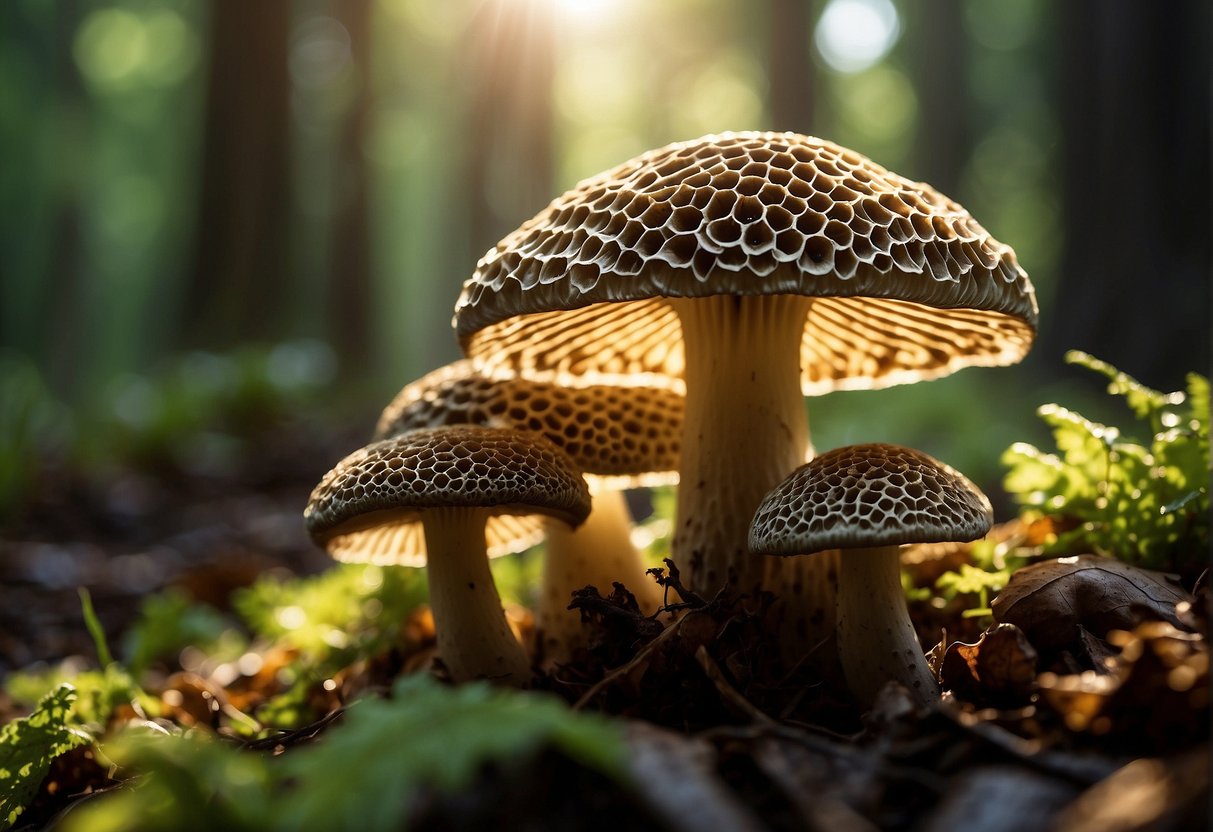
The Ohio morel mushroom season is an exciting time for foragers who eagerly await the spring thaw. It’s a narrow window where conditions must align perfectly for Morels to appear.
Timing and Climate Factors
Spring in Ohio heralds the arrival of morel mushrooms, with the season typically starting in mid-April. Your best chance to find them is when the days settle into a pattern of warmth and moisture. Morels favor a series of rainy days followed by warm, sunny weather to start fruiting. Depending on the variety, you’ll want to look for these mushrooms when daytime temperatures are consistently between 50 and 70 degrees Fahrenheit.
- Half-Free Morel: Thrives when the days are consistently around 61-68°F.
- Gray Morel: Prefers slightly cooler days, roughly 58-64°F.
- Yellow Morel: The most prized, emerges when temperatures reach 71-77°F.
Keep your eyes on the soil temperature too; morels appear when the ground hits about 45-50 degrees Fahrenheit.
Regional Variations
Your success in hunting morels can also depend on where in the Midwest state you are. Ohio’s topographical diversity means morel seasons can differ by region. In southern Ohio, the season can begin a week or two earlier than in the northern parts of the state due to the warmer climate.
- Southern Ohio: Warmer temperatures mean an earlier start to morel season.
- Northern Ohio: Cooler climate leads to a slightly later season.
Forest composition can also affect morel abundance. Morels often associate with certain trees, such as elms, ashes, and poplars. Burn sites from previous years can also be hot spots for morels the following spring, so if you’ve noticed controlled burns or wildland fire areas, mark those on your map for future exploration.
Remember, respect the environment and practice sustainable foraging, ensuring that these treasures of the Midwest forests continue to appear for years to come. Happy hunting!
Morel Foraging Techniques
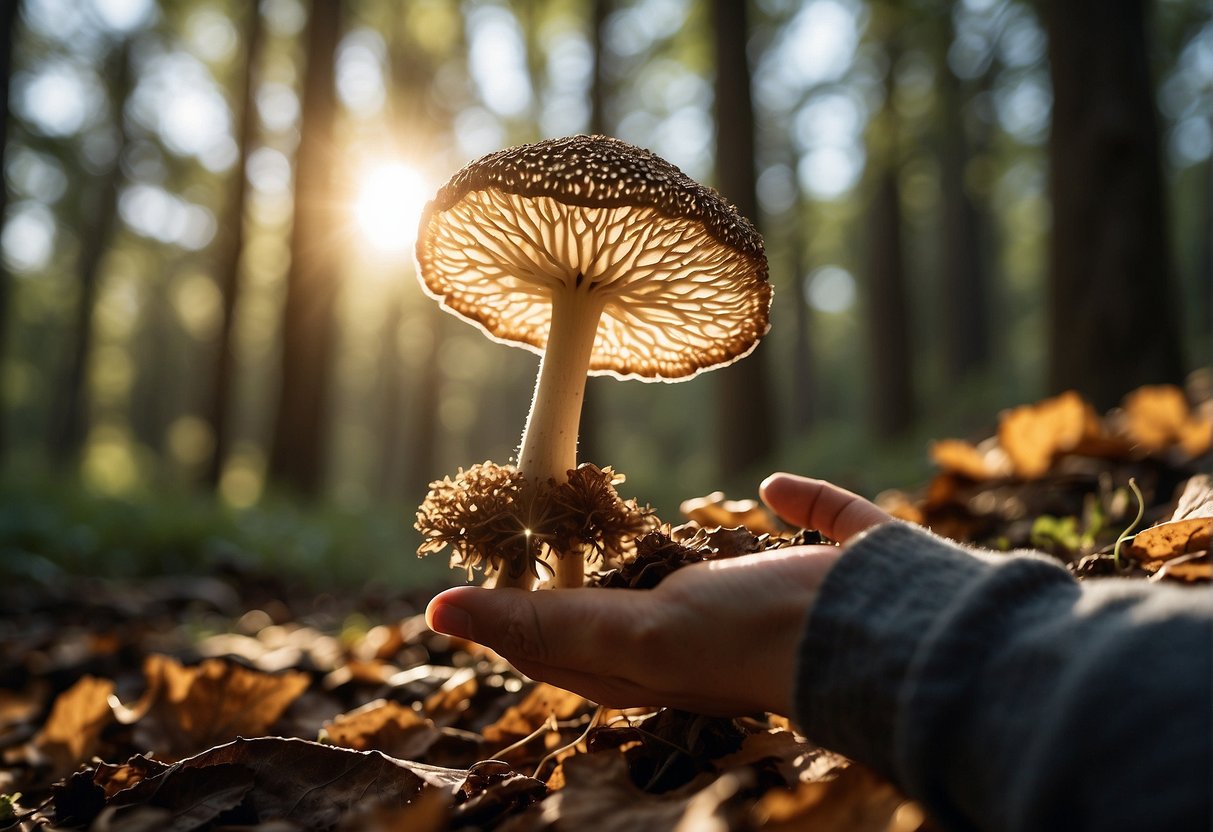
Venturing into the woods for morel mushrooms can be rewarding if you’re well-prepared and know the rules. These pointers will equip you for a successful forage.
Equipment and Preparation
Before you head out, ensure you have:
- GPS device or app: Vital for navigation and marking spots where you’ve found morels.
- Mesh bags: These allow spores to spread as you walk, encouraging future growth.
- Comfortable hiking gear: Protect yourself from elements and terrain.
- Sharp knife: For cutting morels at the stem without damaging the mycelium.
Remember to check the weather and download offline maps if you anticipate a weak signal.
Safety and Regulations
Your safety and adherence to local laws should always come first.
- Know your mushrooms: False morels are toxic. Be sure you can identify true morels confidently or bring a guidebook.
- Stay aware of your surroundings: Keep a lookout for wildlife, and know how to navigate back to safety.
- Regulations: Familiarize yourself with state and park rules about mushroom hunting. Some areas may require permits for off-trail collecting.
- Leave nature as you find it: Minimize impact by staying on trails when possible and practicing “Leave No Trace” principles.
Use these tips to make your morel hunt not only enjoyable but also respectful to the ecosystem you’re exploring.
Using and Preserving Morels
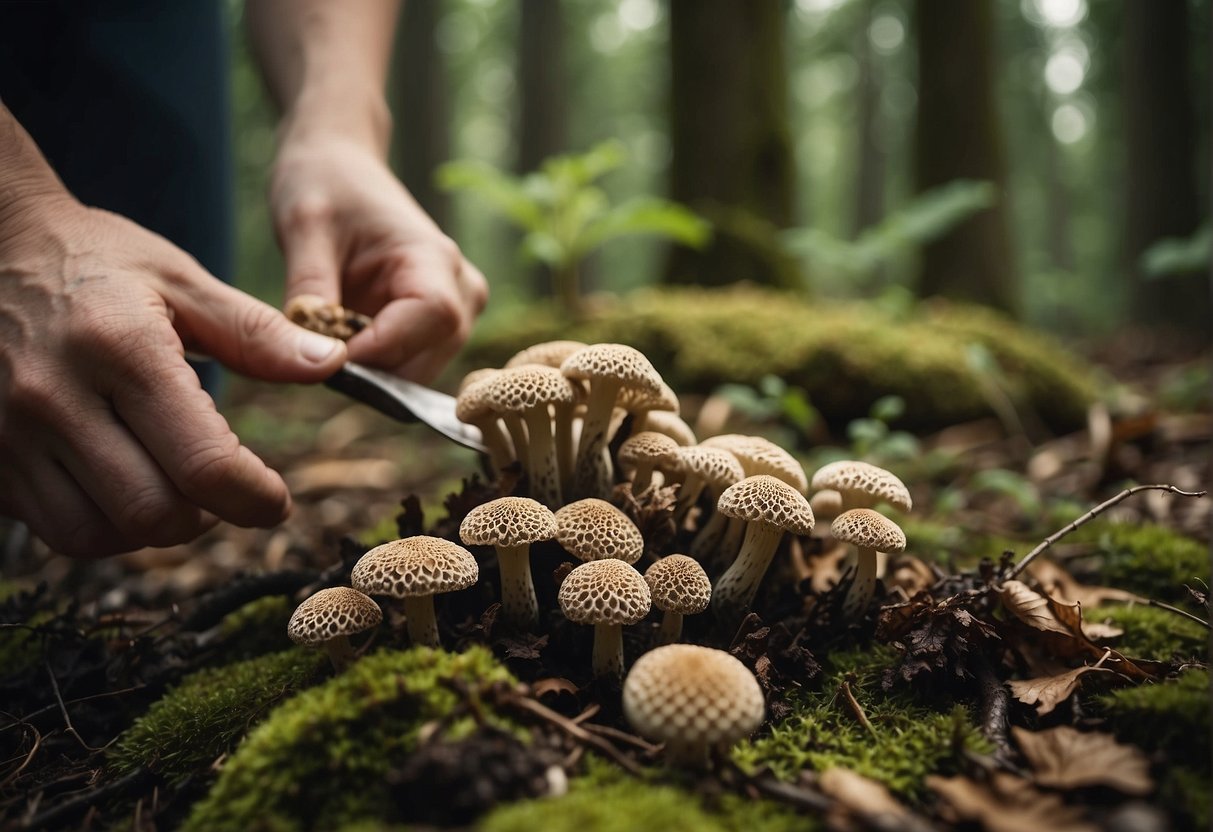
When you’ve hit the jackpot during a foraging trip in Ohio, knowing how to clean, cook, and store morel mushrooms ensures you can savor their distinctive earthy flavor for months to come. Here’s how to get the most out of your morels while keeping their unique taste profile intact.
Cleaning and Cooking
Before you cook with morels, cleaning them thoroughly is crucial since they often harbor debris from the forest floor. Don’t soak them; instead, rinse each morel quickly under cool running water and slice them lengthwise, flushing out any hidden grit. Pat them dry gently with a paper towel. When cooking, sautéing them in a bit of butter brings out their subtle, nutty flavor which is a delectable compliment to meats or an aromatic addition to sauces. For a sweet twist, pair your morels with apple slices for a contrast that highlights the mushrooms’ earthiness.
Storage Methods
To preserve morels, you have several methods at your disposal:
-
Drying: Arrange your cleaned morel halves on a baking sheet or dehydrator tray. Ensure they’re not touching and dehydrate at a low temperature until they’re brittle to the touch. Store them in an airtight container at room temperature.
-
Freezing: If you prefer preserving the flavor similar to fresh, opt to freeze your morels. After cleaning, you can either freeze them whole on a baking sheet before transferring to a freezer bag or sauté lightly beforehand. Frozen morels are ideal for stews and soups, as the texture can change post-thaw.
By adhering to these methods, you’ll be able to enjoy your foraged morels all year round, ensuring not a single edible treasure goes to waste.

